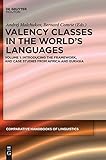Valency Classes in the World’s Languages. Volume 1, Introducing the Framework, and Case Studies from Africa and Eurasia / ed. by Andrej Malchukov, Bernard Comrie.
Material type: TextSeries: Comparative Handbooks of Linguistics [CHL] ; 1/1Publisher: Berlin ; Boston : De Gruyter Mouton, [2015]Copyright date: ©2015Description: 1 online resource (873 p.)Content type:
TextSeries: Comparative Handbooks of Linguistics [CHL] ; 1/1Publisher: Berlin ; Boston : De Gruyter Mouton, [2015]Copyright date: ©2015Description: 1 online resource (873 p.)Content type: - 9783110332940
- 9783110395273
- 9783110338812
- online - DeGruyter
- Issued also in print.
| Item type | Current library | Call number | URL | Status | Notes | Barcode | |
|---|---|---|---|---|---|---|---|
 eBook
eBook
|
Biblioteca "Angelicum" Pont. Univ. S.Tommaso d'Aquino Nuvola online | online - DeGruyter (Browse shelf(Opens below)) | Online access | Not for loan (Accesso limitato) | Accesso per gli utenti autorizzati / Access for authorized users | (dgr)9783110338812 |
Frontmatter -- Contents -- Abbreviations -- Acknowledgments -- List of authors -- Part I: The Leipzig Valency Classes Project: Introducing the Framework -- 1. Introduction -- 2. Leipzig Questionnaire on valency classes -- 3. Comparing verbal valency across languages -- 4. Valency classes and alternations: parameters of variation -- 5. Transitivity prominence -- 5a. Assessing transitivity prominence from a statistical perspective: A commentary on Martin Haspelmath’s “Transitivity prominence” -- 6. Statistical observations on implicational (verb) hierarchies -- Part II: Case Studies -- Africa -- 7. Valency in Nllng -- 8. Valency properties of Mandinka verbs -- 9. Emai valency classes and their alternations -- 10. Valency classes in Yorùbá -- 11. Valency properties of verbs in Modern Standard Arabic -- Eurasia -- 12. Icelandic valency classes: oblique subjects, oblique ambitransitives and the actional passive -- 13. Valency patterns in Italian -- 14. Valency classes in Eastern Armenian -- 15. Valency and valency classes in Bezhta -- 16. Valency classes in Even (North Tungusic) in a comparative Tungusic perspective -- 17. Valency properties of the Ket verb clause -- 18. Flexible valency in Chintang -- 19. Valency classes in Mandarin -- 20. Valency classes in Japanese -- 21. Valency classes in Ainu -- Language index -- Subject index
restricted access online access with authorization star
http://purl.org/coar/access_right/c_16ec
Earlier empirical studies on valency have looked at the phenomenon either in individual languages or a small range of languages, or have concerned themselves with only small subparts of valency (e.g. transitivity, ditransitive constructions), leaving a lacuna that the present volume aims to fill by considering a wide range of valency phenomena across 30 languages from different parts of the world. The individual-language studies, each written by a specialist or group of specialists on that language and covering both valency patterns and valency alternations, are based on a questionnaire (reproduced in the volume) and an on-line freely accessible database, thus guaranteeing comparability of cross-linguistic results. In addition, introductory chapters provide the background to the project and discuss its main characteristics and selected results, while a series of featured articles by leading scholars who helped shape the field provide an outside perspective on the volume’s approach. The volume is essential reading for anyone interested in valency and argument structure, irrespective of theoretical persuasion, and will serve as a model for future descriptive studies of valency in individual languages.
Issued also in print.
Mode of access: Internet via World Wide Web.
In English.
Description based on online resource; title from PDF title page (publisher's Web site, viewed 25. Jun 2024)


